Email best practices
How to create an email newsletter

Email best practices

So, you’ve decided to create an email newsletter. Hooray for you! Or maybe someone’s suggested you launch one, and you really have no idea what they’re talking about? Whether you’re an email newbie or you just want to make sure you’re doing things correctly, we’ve got you covered.
Right on cue, here’s the best email newsletter post ever.
An email newsletter is a type of email sent out by companies or individuals to a subscriber list. That list should include existing or potential customers that have signed up and given clear consent to receive digital marketing communications from your brand. Email newsletters are sent regularly and contain valuable content like guides, blog posts, news, product reviews, personal recommendations, tips, announcements, and other resources.
Newsletters are an essential part of an email marketing strategy. They allow businesses to nurture their contacts by establishing themselves as key players in their industry, sharing insights, and highlighting new products that will drive traffic to the website.

Email newsletters are one of the most popular ways to nurture existing and potential clients. This is largely in part to its low cost and great return on investment (ROI). Email marketing is one of the most effective marketing channels for both SMBs and enterprise level companies. The average email marketing ROI is $35 for every $1 spent, with 75.4% of consumers saying email is their channel of choice when hearing from brands.

Data from a new Sinch Mailjet report, The path to email engagement, shows that email has in fact increased in popularity since 2021.
Well-designed marketing emails sent regularly, like email newsletters, webinars, event registrations, and product sales guarantee constant website traffic. Newsletters generally form the largest part of all marketing emails sent and hold a great deal of potential.
Wondering whether setting up an email newsletter is the right step for your business? Let’s have a look at the advantages and drawbacks of sending one.
|
Pros |
Cons |
|---|---|
|
Constant source of traffic |
Absence of physical experience |
|
Considerable savings |
Ease of deletion |
|
Easy performance tracking | |
|
Independence from third parties | |
|
Easily linked to other marketing channels |
Creating a newsletter is not just a way to keep your customers informed about your new products or features, they have many other advantages.
One of the main reasons for creating a newsletter is that it generates regular website traffic. Organic engagement on social media platforms like Facebook is declining dramatically. Banner advertising is rarely noticed in the era of ad blockers. Written press releases sent by email will often be ignored by journalists and online editors.
Luckily, this is not true for newsletters. Emails that reach someone’s inbox are usually seen, and the likelihood that they will be opened is around 20-25%. Provided that the email subject line is appealing and the sender is recognized (so make sure your readers know who you are!) If your newsletter is well designed and contains relevant content, this will enhance your chances of the reader clicking on the calls-to-action (CTAs) for more information.
Budget is important to marketers. So, anything that saves you money should be a top priority – and newsletters do.
Don’t underestimate how much money email marketing saves you compared to using other marketing tools. Paid advertisements like banner advertising, Google AdWords, Facebook Ads, and influencer marketing are considerably more expensive than email marketing.
Measuring the performance of an email newsletter is simple. Your email statistics provide you with all the information you need to do this: open rates, click rates, unsubscribe rates, bounces, device used to open the newsletter and when, which links are clicked on, etc. These metrics, along with UTM tags to track engagement through Google Analytics, will help you accurately calculate your ROI and produce target-audience-relevant newsletter content.
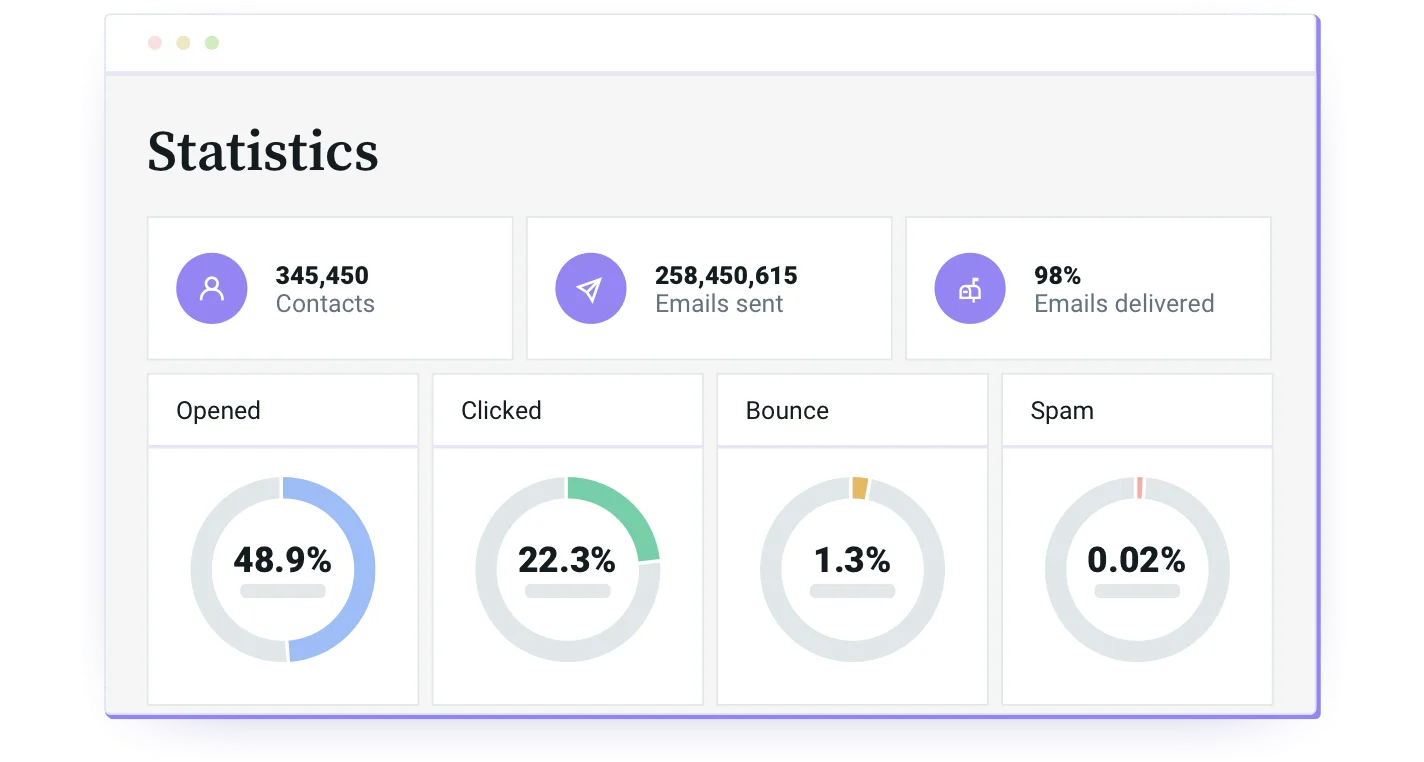
When you create a newsletter, you are independent of other service providers and software. Publishers, influencers, social media platforms, and Google are much more likely to increase ad costs than email service providers (ESPs) are.
Newsletters and other marketing tools like social media can be easily and effectively combined. And they can reach recipients anywhere, regardless of whether they are in the office on their work computer, on the sofa at home on a tablet, or on the go on their smartphone. Emails can be opened and read anywhere.
Readers and subscribers want regular and consistent communication from you (hence why they signed up to your newsletter!) However, manually creating, segmenting and then sending this content is time consuming and often prone to delays/problems.
This is where email automation comes in handy. Most ESPs – including Sinch Mailjet – allow you to schedule your newsletters in advance at a specific cadence (weekly, bi-weekly, monthly, etc.), saving you a ton of leg work while ensuring any issues can be ironed out well in advance.
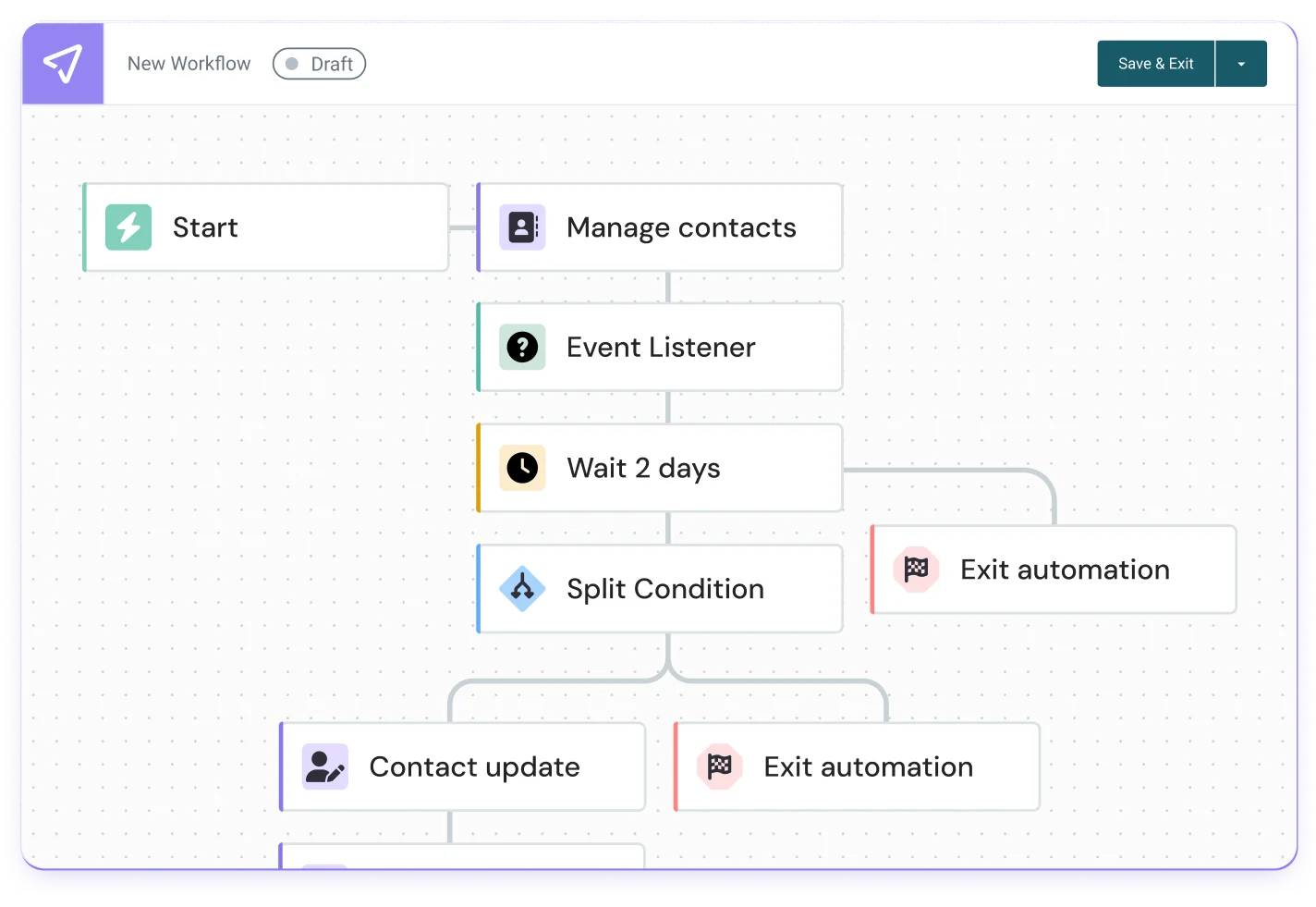
Where there’s yin, there is yang. Where there is light, there is also darkness. While email newsletters provide many benefits, there are also a couple of cons to consider.
Unlike analog advertising media like brochures, flyers, magazines, etc., there is no haptic experience with email newsletters. For instance, a desk calendar is visible all year round. Emails, on the other hand, are intangible.
Emails, therefore, have a shorter lifespan but are also less annoying to organize and are better for the environment.
Let’s be honest, emails tend to be deleted quicker and are more likely to be skimmed through than physical media. There are many reasons for this: a full inbox, unappealing subject lines, irrelevant content, etc.
Although we can optimize our messages to prevent this, a 100% engagement rate can never be guaranteed. This is true not only for newsletters, but for all marketing tools.
OK, so we have convinced you to give newsletters a go. Hooray! To help you make the most of your new favorite marketing channel, we’ve detailed below all you need to know to plan an effective newsletter strategy. Your competitors will wish all their emails were like yours.
Here are the steps you should follow to create an email newsletter for your business:
Let’s run through the nuts and bolts of good email marketing.
First things first. Before you even start designing your email newsletter template, you’ll need to think about why you want to implement one. Consider the following elements to ensure you’re crafting the right messages.
Defining your audience is essential to the success of your campaign. You need to understand your potential readers’ needs and wants to provide value and send newsletters that appeal to your audience.
So, think about who you want to reach with your emails and try to be as specific as possible. Consider things like demographics, location, and interests.
What do you want to achieve with your email newsletter campaign? Some companies launch newsletters to drive traffic to their website, others want to increase sales on their online shop or to invite people to upcoming events.
Setting goals gives your newsletter campaign a purpose and helps you measure the performance of your efforts. These specific objectives depend on your company’s goals, vision, and values.
Once you have defined your objectives, you need to determine the KPIs you want to track. If you’re not sure where to start, you might want to consider some of the most typical metrics measured for newsletters:
Planning the topic of your newsletter is closely connected to the objectives you have defined, but coming up with content can be hard at first.
To find inspiration, analyze your competitors’ newsletters and newsletters from companies you think are successful at email marketing. This will give you some ideas for new potential topics, products, events, etc.
Here are some examples of newsletter content you could include:
You can also carry out a survey in advance and ask your contacts to share their thoughts as you grow your newsletter list.
Before you start creating newsletters, you need to find a email newsletter service that allows you to create, send, and analyze email campaigns.
The problem is that there are many professional newsletter solutions on the market, which can be both a curse and a blessing for senders.
So, what should you look for in email marketing software?
Here are a few features that can help you make the most of your email program:
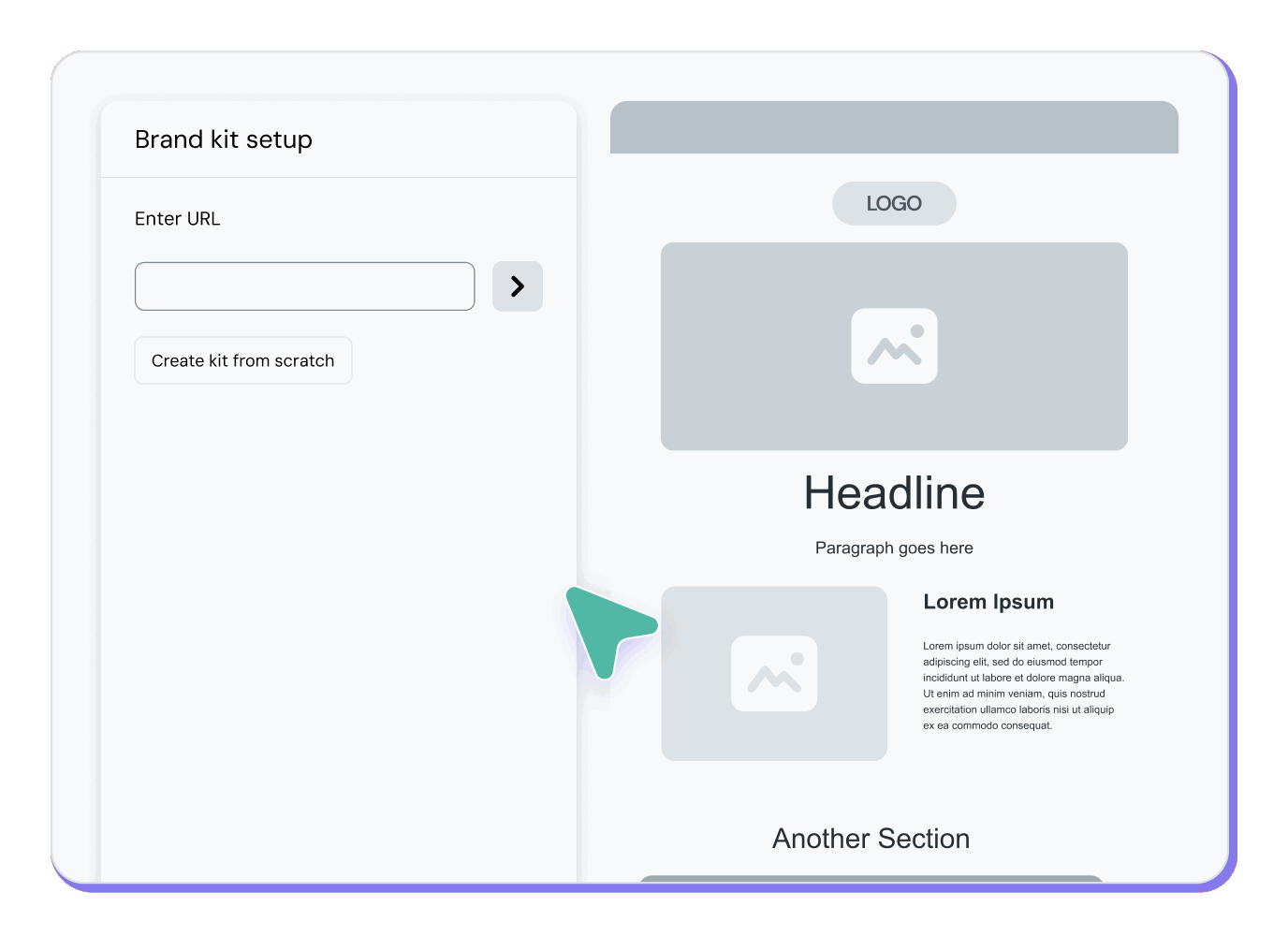
Mailjet’s email newsletter service simplifies this process by letting you store and apply your brand’s fonts, colors, and logo to every email by just copying and pasting your URL. This ensures that every email matches your brand identity, whether it’s created by you or another team member.
In order to be able to create and send a newsletter, you obviously need recipients (duh!).
Setting up an email contact list with high interaction rates is relatively simple if you take certain factors into consideration.
To gain new subscribers, the first thing you’ll need is a responsive subscription widget with a double opt-in process.
Add the subscription sign-up form to all the relevant pages of your website. Some of the most effective places to include your widget are the homepage, the blog, the footer, and pages with gated content, such as guides, white papers, and others.
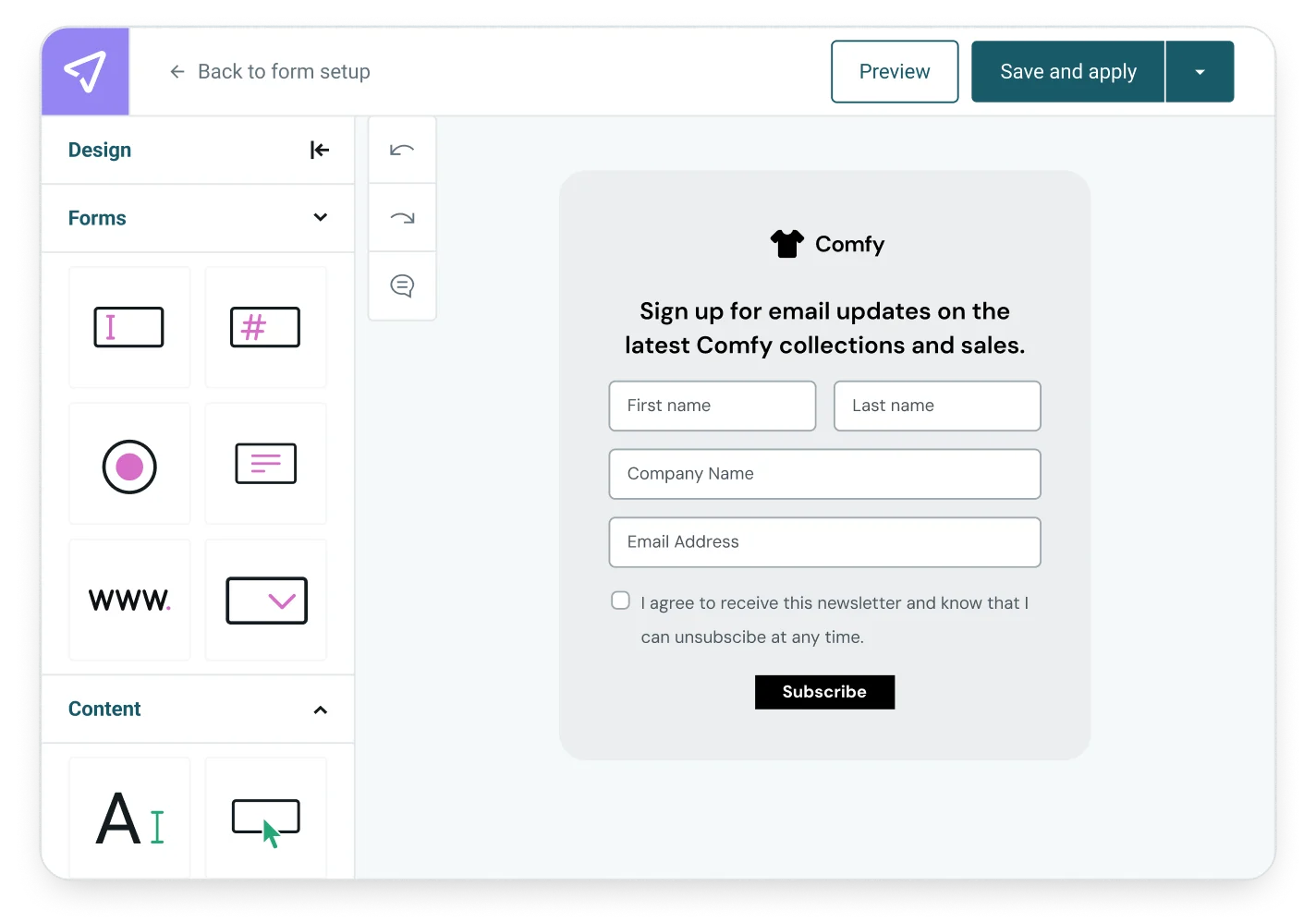
Mailjet allows you to create responsive subscription widgets.
Don’t forget to add a double opt-in to your sign-up process. Double opt-in ensures that no fake email addresses creep into your database and damage your reputation and deliverability. If you’re not doing this, you risk being classified as a spammer both by recipients and the inbox service providers (ISPs) themselves.
Giving in to the temptation of buying email addresses will result in the same scenario. Purchasing email contacts from third parties is still very popular because many companies still believe that an email contact list must be as large as possible to be successful. This is by no means true, trust us. Buying contact lists is essentially a waste of money.
People included in such lists usually don’t want to hear from you at all, so this usually results in spam complaints and unsubscribes. These lists also tend to include spam traps, which can severely hurt your deliverability.
Besides implementing a responsive subscription widget, special newsletter lead capture landing pages are a great way to grow contact lists. These pages enable you to use all the optimization opportunities that apply to landing pages.
The potential newsletter subscriber is not distracted from other elements on the website. So, they concentrate on all the great reasons your newsletter is the best thing that has been written since Harry Potter.
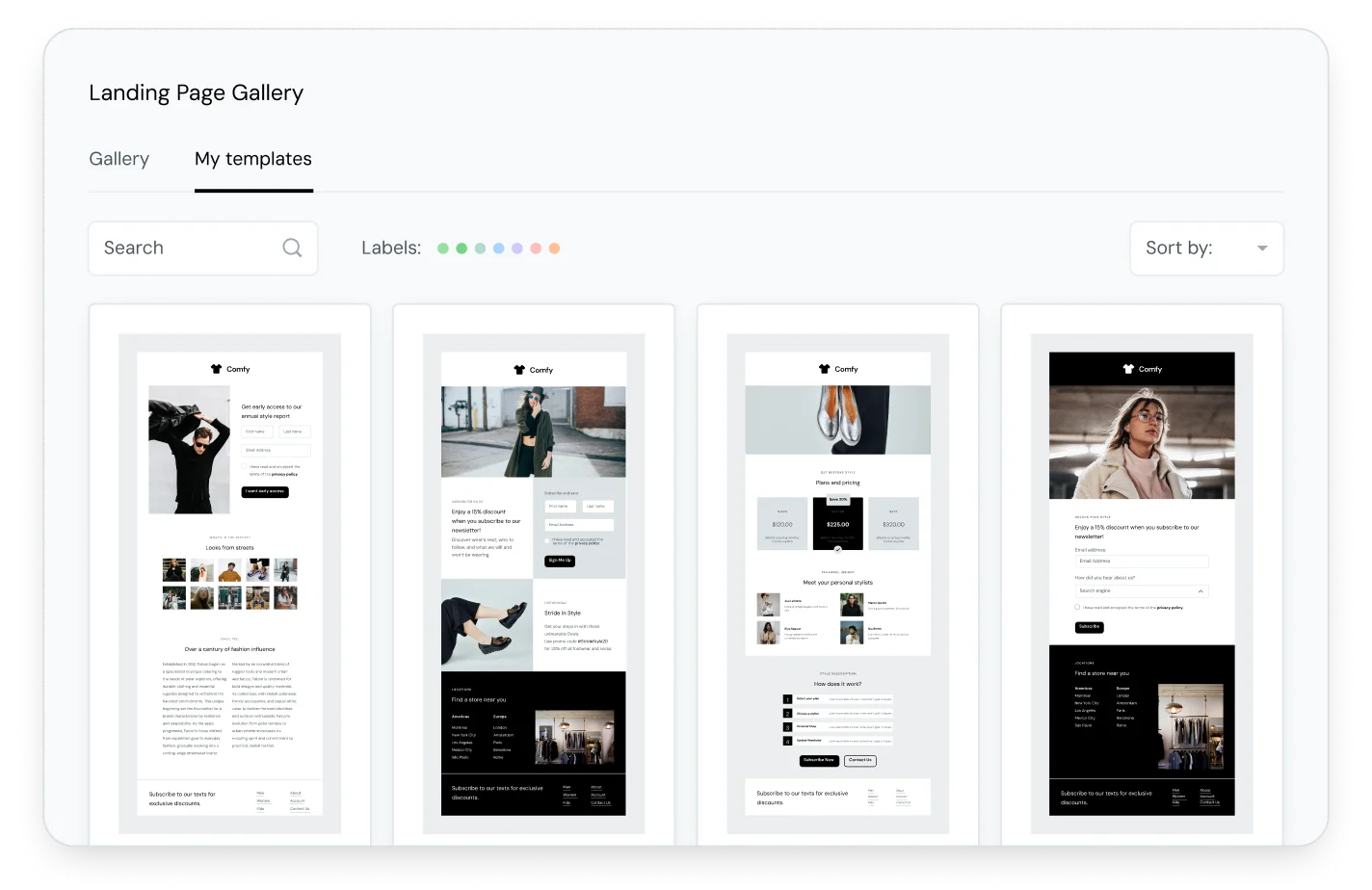
Create a cohesive brand experience for your subscribers by synchronizing your email marketing campaigns with Sinch Mailjet’s built-in landing page builder tool.
There are other ways of growing your email lists, such as promoting it on your social media platforms, incentivizing existing subscribers to share, or encouraging people to join at events or your physical store.
Consider what benefits prospective recipients may have if they subscribe to your newsletter. Ideally, you have already clarified these reasons in your strategy. Real added value, for example, is provided by things like:
But remember, regardless of how you’re getting your subscribers, you should always ask for consent before adding anyone to your email database. Remember what data protection and spam laws (like GDPR) say about consent, and ensure you’re complying with the applicable regulations.
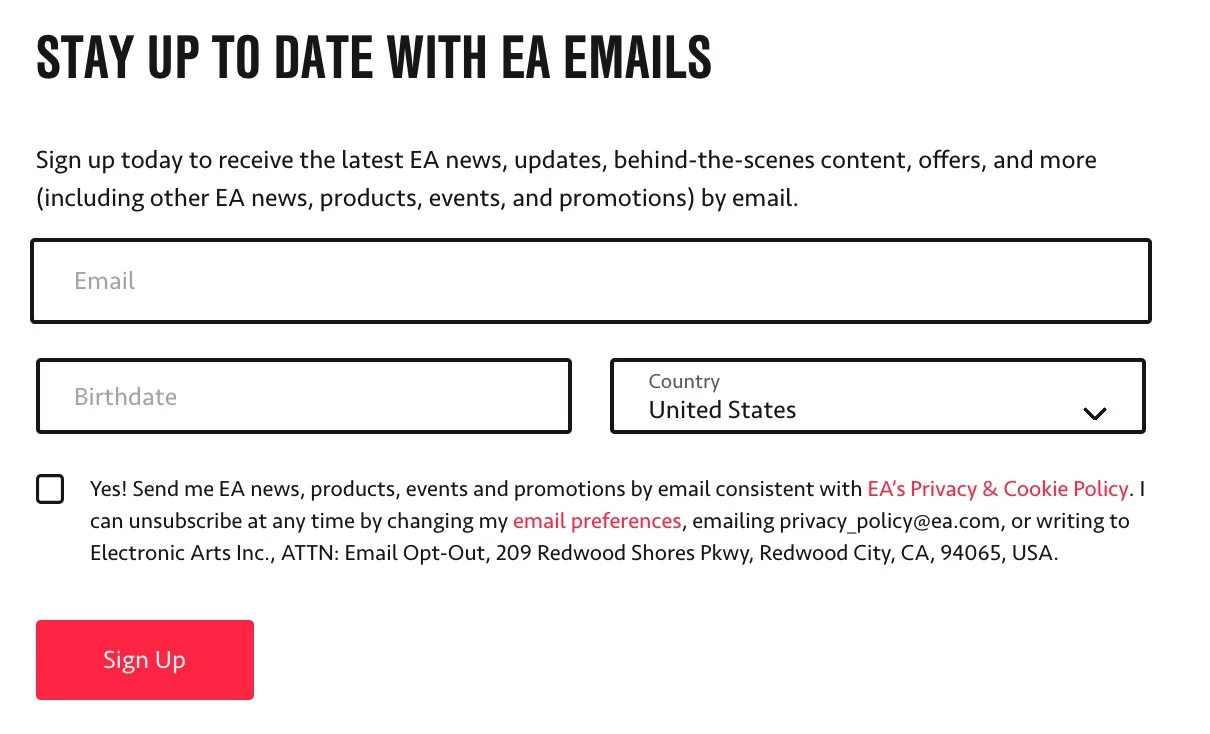
Instead of sending the same message to all your customers, leverage segmentation to make the most of your emails.
Think about how you can use the information you have about your customers to create segments and send tailored email marketing campaigns that really speak to that group.
Determine the kind of data to use to segment your list. Think about what would make sense for your business and consider if there are some obvious ways to group your customers based on different characteristics.
To give you some inspiration, here are a few examples of the kind of data you can use:
|
Demographic data |
Psychographic data |
Behavioral data |
|---|---|---|
|
Gender |
Product preferences |
Past purchases |
|
Location |
Interests |
Average spending |
|
Age |
Lifestyle |
Purchase frequency |
If you want to get even more specific about your segments, you can combine different types of data and create even more precise groups. For example, you could focus on only women that prefer shopping for shoes and that have made a purchase over the past six months.
Once you have different groups of customers with similar characteristics, interests, or habits, it will be easier to understand each segment and craft messages that resonate well with each one.
The first step to creating a newsletter is setting up an email template. You can use a newsletter template provided by your ESP (ours are pretty cool!) and adapt it as necessary to match your brand image and your needs.
Alternatively, you can upload an HTML newsletter template you have already created or that you have bought from a third party. In this case, make sure that the selected layout is responsive so that your email campaigns will be perfectly displayed on every end device.
Ready to dive in? There are five main things to consider when designing an email.
The first thing to consider when putting a newsletter template together is content. Is it relevant to your audience? Is it engaging enough? Does it follow your brand guidelines? Keep your content brief and to the point, as you only have the reader’s attention for a small amount of time.
Use images on top of your email to capture the reader’s attention, followed by brief text and a clear call to action.
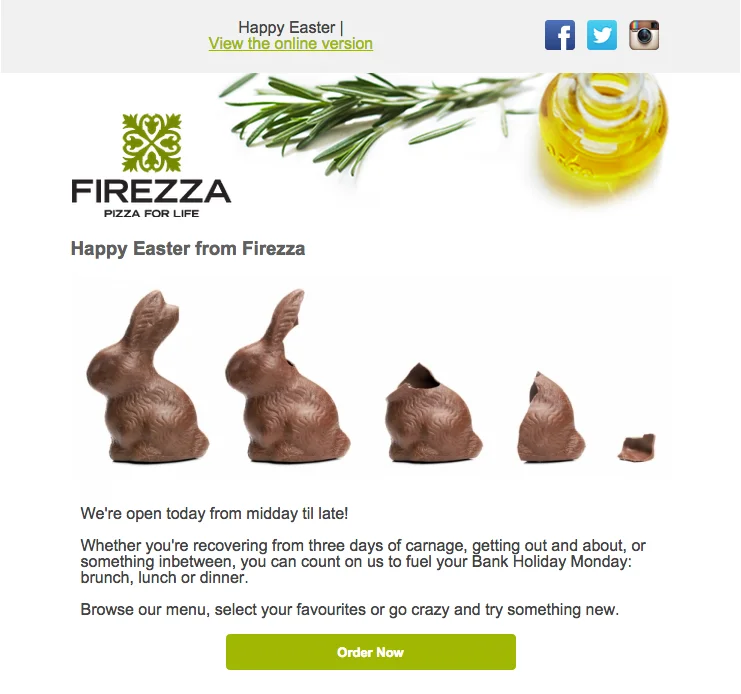
Give your newsletters a consistent design and don’t cram your email with too much information. Provide plenty of white space and keep your newsletter simple and neat.
A clear structure ensures that subscribers grasp the content and core message(s) immediately. Insert your company logo in the upper section so that the readers immediately associate the newsletter with you. Add images in order to attract the readers’ attention, followed by a brief text and a clear CTA.
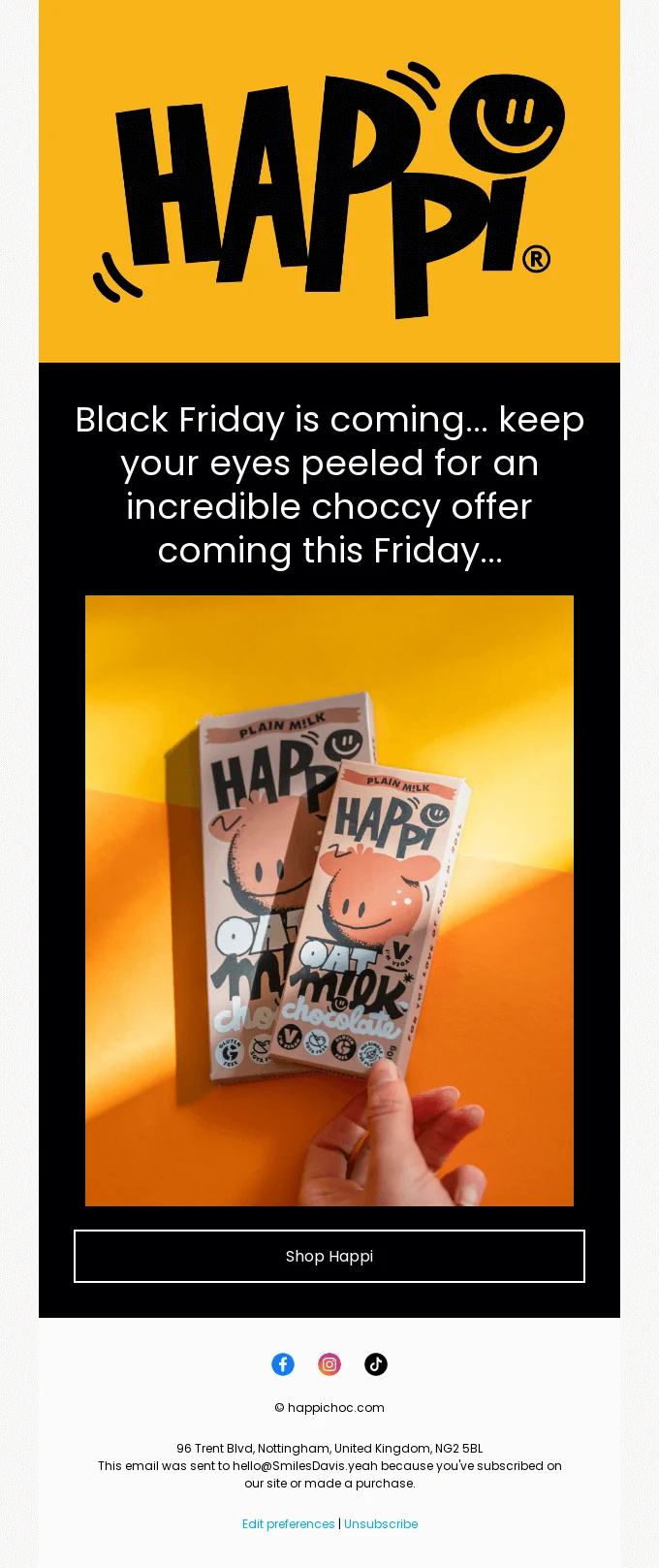
To have your email render on various devices, be mindful of your email size. The ideal width is between 500 – 680 px. Our article “Email design: Trends and best practices” offers a comprehensive guide on email design best practices.
Make sure that you’re keeping true to your brand identity and think about your audience. Using specific colors based on your demographic and seasonal themes, you can improve your results and ultimately ROI.
Consider your demographic to choose your color scheme and use relevant colors to match certain seasons, like crimson red for Christmas and brown for fall. Finally, ensure your colors have good contrast with a dark background.
Images and other visual elements optically enhance the newsletter. But beware – image-heavy emails can negatively impact your deliverability. Internet service providers (ISPs) know this well and often block emails containing large images. So always aim for a healthy 60:40 balance between text and graphics.
Remember to add alt tags to the images and scale them down to the size you want. Always consider accessibility best practices and bear in mind that some email clients block images so that subscribers will just see a large white area. By adding alt tags, they’ll at least get an idea of what they should be looking at.
If you want your users to take action through your emails, don’t be too pushy with your CTA buttons.
Think about the placement of your CTAs and always have your main CTA above the fold (the page you can see without scrolling). Research, A/B test, and compare your campaigns to improve the text used in your CTAs to increase your click-through rate.
In an increasingly mobile world, your content and entire funnel must be optimized for mobile devices. Studies have found that at least 41% of emails are opened on mobile first. In other words, if you haven’t already optimized your newsletters to mobile devices, now is a good time to do it.
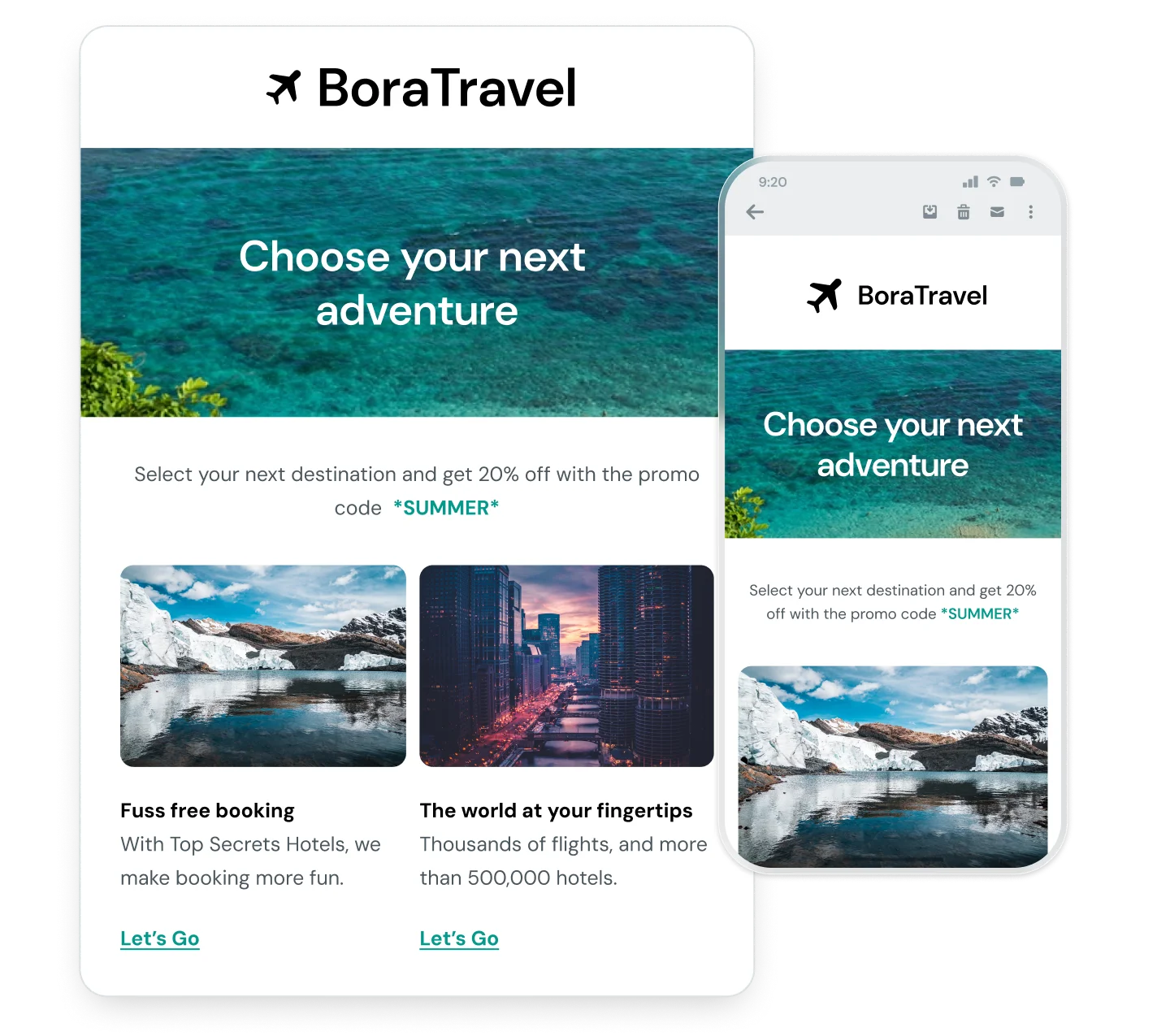
Mailjet’s responsive email rendering across devices.
To get you started, we have gathered a few of the most important steps to take while optimizing your campaign for a mobile audience:
An essential part of email design is the content featured in the newsletter. Yes, this might sound obvious, but it’s still forgotten by many that think a flashy design is enough to wow their contacts.
Whether you got inspiration from other newsletters or by conducting a survey, carefully map out the messages you want to share and consider how you’ll communicate these to your audience. Define your email voice and the stories you want to tell, paying special attention to your copy.
Need some content ideas for your newsletter? Here are a few:
Remember that the content you share in your emails should be directly linked to your goals and objectives and provide value to the reader. Place the most important information first and organize the rest following a clear hierarchy.
We’ve talked a lot about how, just as the saying goes, first impressions really do count when it comes to the subject line. Think about this: If your email is the vault and the content inside is the treasure, your subject line is the key.
Remember that the tone and language should match the style of your brand. Be bold and try out something new. Being cheeky, using questions, citing the recipient’s name, or even adding emojis, all jazz up the subject line and draw attention to your newsletter.
If you’re looking for inspiration when it comes to writing your newsletter subject lines, try the new Mailjet Assistant. You can customize your audience details, adjust the copy’s length, and select your desired tone and languages to ensure your message aligns perfectly with your brand voice.
Also, don’t forget about your “From Name” and pre-header. For the “From Name”, don’t just use your company or department name, but make sure it’s easily recognizable.
The pre-header summarizes the email content and motivates the recipient to pay attention to your newsletter. So, make sure it works together with your subject line to incite the readers and encourage them to open your email.
If you conduct email marketing activities, you must adhere to certain legal guidelines. This means that your newsletter must contain an unsubscribe link.

With your content ready to go, it’s time to start sending your newsletters. As we mentioned before, the easiest way to go is by using an email marketing service that lets you integrate your contact list, create your newsletter layout, and send your emails in one platform – like Mailjet.
Make sure to choose a service that offers tools for tracking and analyzing the newsletters you send. It’s important to see how your audience responds to the emails you’re sending them. Most email newsletter services offer tracking of delivery, opens, clicks, and unsubscribes, which are essential in measuring your efforts.
Here are the main metrics explained:
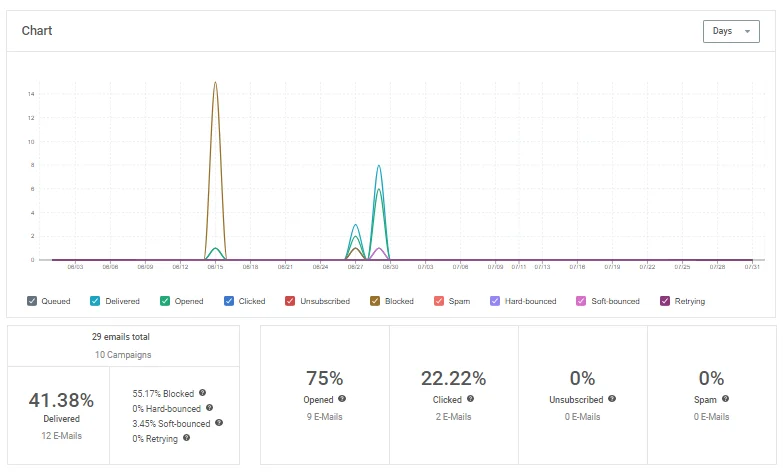
Optimize future newsletters with Mailjet’s campaign reporting tool.
Once you’ve sent your first few newsletters, the opens and clicks should give you an initial idea about how your audience is reacting to your emails. This data is a great source for deciding how to optimize your future newsletters.
Make sure you know how to read email stats properly and how to identify what needs to be improved. If your open rate is low, perhaps your subject line isn’t clear enough. If only a few people click on the links in your newsletter, try to make your CTA stand out more. If a lot of users are unsubscribing, take another look at your contact list or try grouping your contact list into more specific segments to get a more narrowing targeting.
Use this data to determine the exact performance of your newsletter and make any adjustments to individual elements. We recommend always implementing these adjustments using A/B testing.
Your newsletter sending time is sent is a crucial factor for success. If you are new to email marketing, try different times and sending frequencies. Testing and comparing the results is the best way to know what works for your business.
In most cases, there are some basic rules about the best time to send emails. If you work in the B2B sector, you should send your newsletter during regular working hours. Peak times are usually between 10-11 AM and between 3-4 PM. If your business model is B2C, then you should send during the week between 6-9 PM and on weekends.
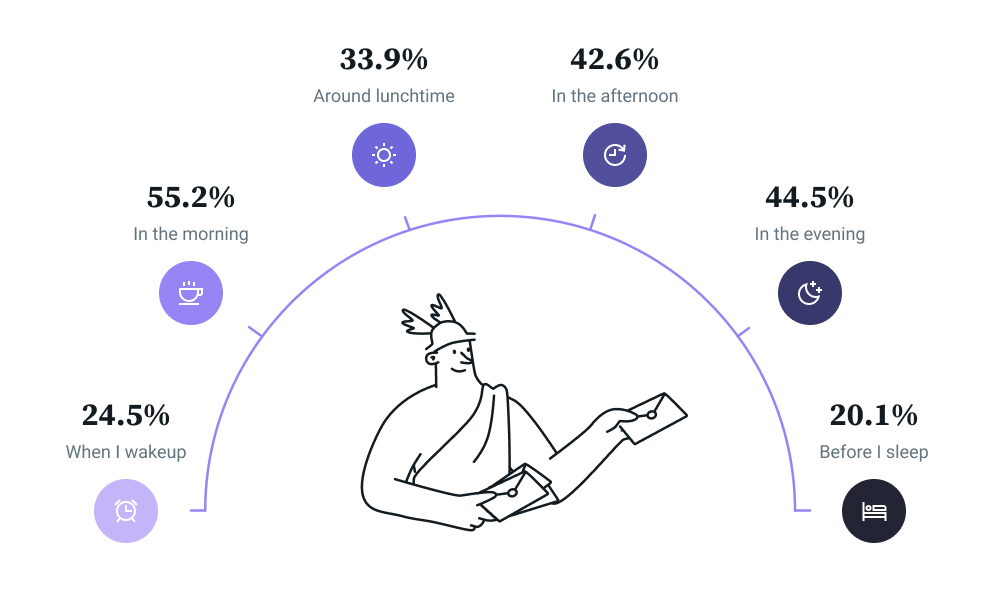
Of course, there are many different tools that can be helpful. Use web analysis software like Google Analytics and analyze the exact time when customers visit your website and send your newsletter based on that time.

Google Analytics shows the best time to send your newsletter.
You can also test to find the best cadence for your company’s newsletter. Weekly and monthly newsletters are the most popular, but that doesn’t mean you need to default to this email frequency.
Find what works best for your business: Keep a close eye on your engagement metrics to understand what works best for your subscribers.
Want to see some of these tips in action? We’ve got a whole blog post with 50 newsletter examples for you to check out, but we’ve also selected four of our favorites below for you to get inspiration and learn the basics.
Check them out below!
What’s great about Product Hunt is how they use their brand identity to their benefit, using their signature red to make their CTA stand out on the white background.
Product Hunt features one key element, which is placed first and adds in-depth value for those avid readers that are always keen to scroll down. Their text-image ratio is also on-point, using their visual elements perfectly aligns with the brand identity.

Check out the full-size Product Hunt newsletter.
Ah, yeah, have we mentioned we love Netflix already? Netflix uses personalized content to make sure their readers keep coming back to their newsletter and find true value in it.
Also, check out their clever use of CTAs! Not everyone will be ready to indulge when Netflix’s email arrives. But by adding a combination of ‘Play’ and ‘My list’, they maximize their click rates and potential conversion.
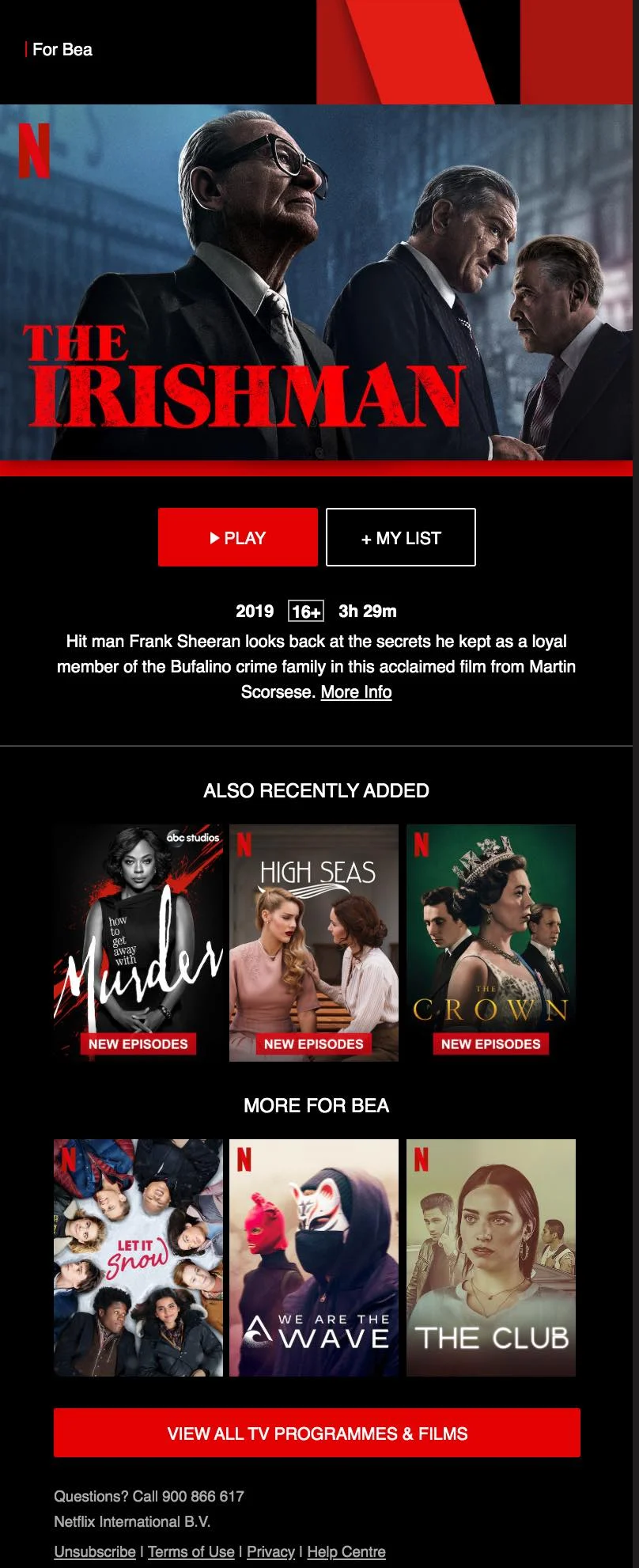
Netflix is one of our all-time favorites.
When someone signs up to the Skyscanner newsletter, they generally know what they’re looking for. Wanderlust-provoking articles with travel tips and suggestions that will help us daydream about being somewhere that’s not the office… And, oh man, do they deliver.
There’s no question about the value that Skyscanner’s content offers, which makes their newsletter a great way to nurture contacts until they are ready to convert. And when they are, they’ll find personalized deals to inspire them and encourage them to click through.

Skyscanner tempt subscribers with attractive offers through their newsletter
At Fitbit, they have a clear goal in mind with their newsletter: to drive traffic to their blog. The content is meant to inspire readers to become more active and make the most of their device. So they highlight their content value at the top (‘Top articles picked for you’) and smartly present their articles with a responsive design that is easy to read (and click!) on mobile.

Check out the full-size Fitbit newsletter
Sending newsletters requires the right email partner that’ll make it easy to create, deliver, and track your email performance.
With Mailjet, you’ll be able to build and manage your email lists using our Form Builder and contact list management features. Plus, you’ll get to carefully segment your database to send content that your readers really want to read.
If you haven’t already, try our drag-and-drop Email Editor, which will help you leverage our amazing template library. Alternatively, build your designs from scratch on the interface to create stunning responsive emails that look good on all devices.
Once your email is sent out through our interface, via SMTP or with our flexible APIs, you’ll be able to effectively track and optimize performance. Use our detailed Email Statistics, A/B Testing, and Campaign Comparison tools to help you take your email to the next level.
Want to learn all that Mailjet has to offer? Check out all our features here!